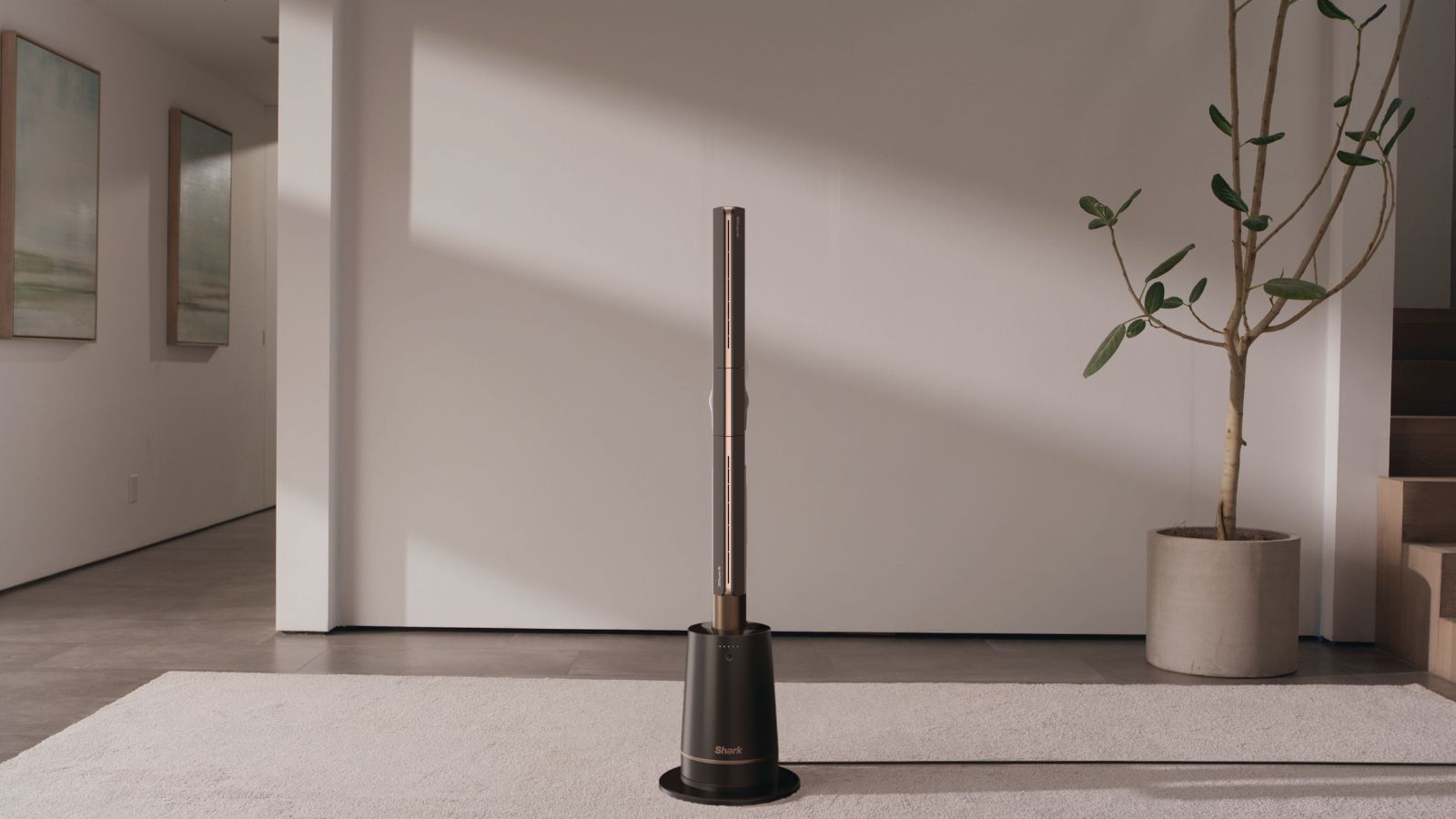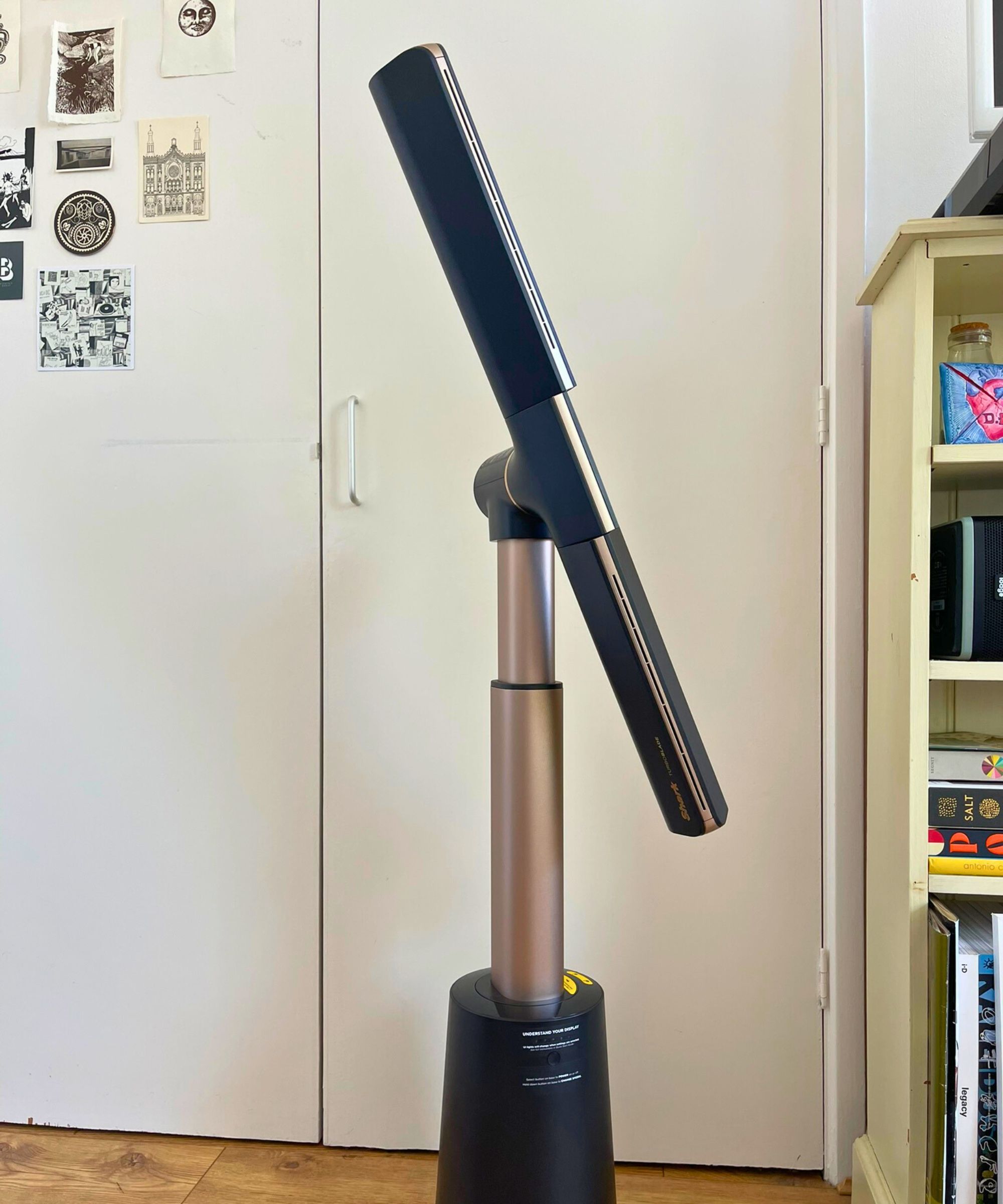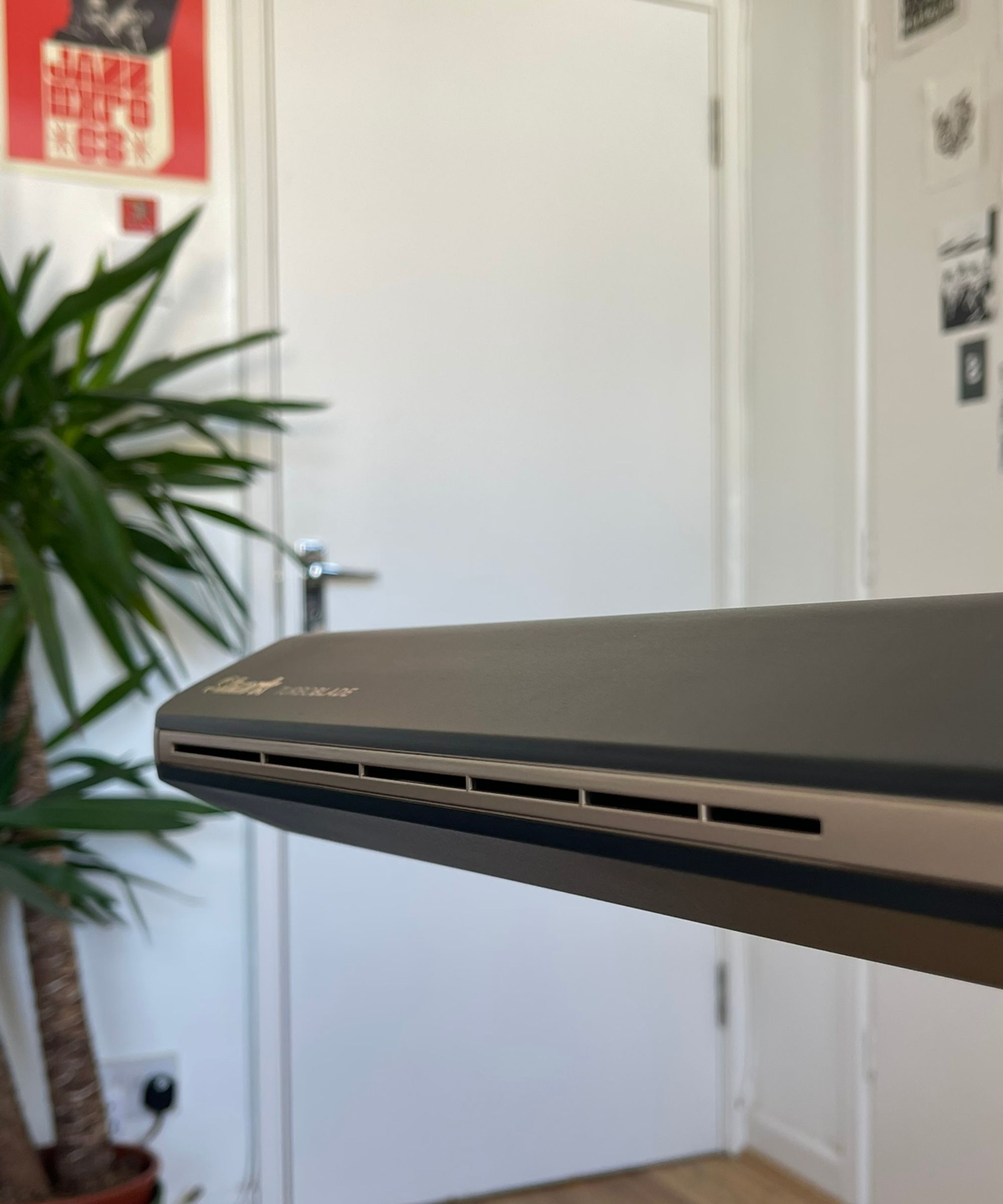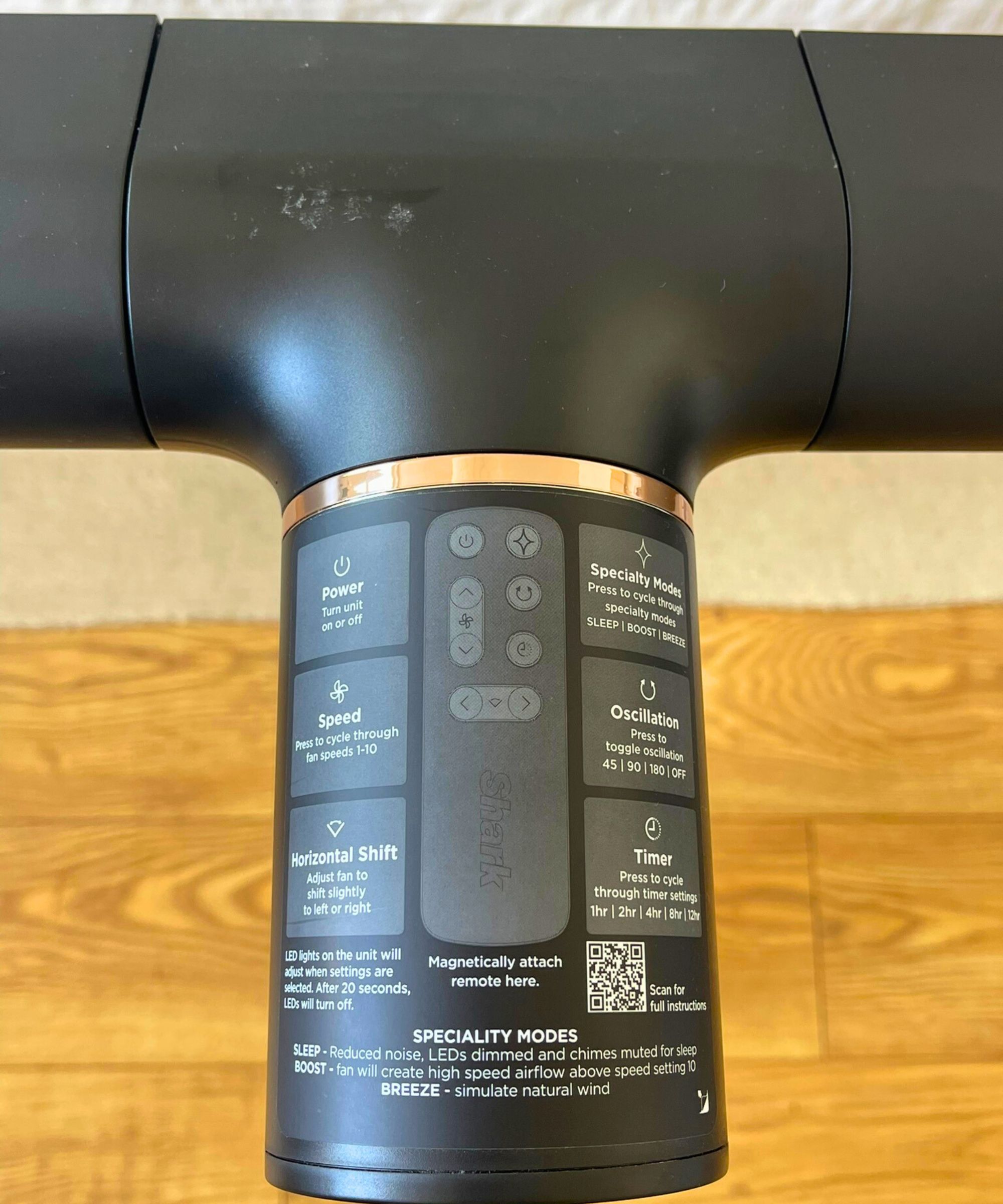I tested the hugely popular Shark TurboBlade, the first fan with multi-directional airflow, during a heatwave – I love how rapidly it cools you down
The sleek, bladeless fan also adds visual impact to any room

Powerful, streamlined, and multi-directional cooling – the Shark TurboBlade does everything you'd hope for in a fan, and more. It's the first on the market to offer multiple airflow directions making it perfect for couples and busy households. However, it's louder and more expensive than similar fans and you can get more bang for your buck elsewhere.
-
+
Strong airflow
-
+
Cools you quickly
-
+
Complete control over vertical and horizontal airflow direction
-
+
Oscillation and timer
-
+
Statement design
-
-
Loud
-
-
Expensive
You can trust Homes & Gardens.
The meteoric rise in popularity of sleek fans such as the Shark TurboBlade comes as no surprise. Taking pride in your home includes making sure your appliances add visual impact, too, while also being able to cool you down in the heat.
So, when Shark announced the TurboBlade with a brand-new and unique design, I was excited to see if it could be the next best fan. It has a feature never before seen in a fan: Multi-directional cooling thanks to vents that can be tilted in any direction to send air to all parts of a room at once.
I tested the Shark TurboBlade in my home during the hot summer months and a particularly gnarly heatwave to find out whether it's worth its $299.99 price. Here's what I learned.
One-minute review
After testing the Shark TurboBlade for three weeks in my home during a heatwave, I found that I love its powerful breeze, slick aesthetic, and the complete control I have over the airflow direction. Being able to rotate the fan horizontally or vertically, and tilt the vents up and down gives you total freedom to have two different airflows, sweep a breeze over the bed at night, or fill a large room while simulating natural wind.
However, you can find fans that can cool you down this effectively for around half the price. It's also quite loud, and similar fans can achieve the same airflow at around 10 decibels less. I recommend it if you're looking for something that will visually elevate a space, and if you specifically need multi-directional cooling, but otherwise I'd recommend a cheaper (and more effective) alternative such as the Shark FlexBreeze.
The Shark TurboBlade is available for $299.99 at Shark.
Shark TurboBlade: Specifications
Type | Bladeless |
Cord length | 6 feet |
Airflow speeds | 10 + Boost mode |
Fan modes | Manual / sleep / boost / breeze |
Noise levels | 29 to 65 decibels |
Timer | 1 / 2 / 4 / 8 / 12 hours |
Oscillation | 45 / 90 / 180 degrees |
Weight | 14.99 pounds |
Dimensions | 11.77 x 31.57 x 44.84 inches |
Shark TurboBlade: Design

With the Shark TurboBlade you can rotate the fan arms in a full 360 degrees, tilt the vents up and down, and aim the air in different directions.
The Shark TurboBlade has a sleek and striking design – one which many of my friends and family have commented that they've never seen before. It's certainly a statement piece, perhaps explaining why it's one of the pricier ways to cool a room with fans.
Design expertise in your inbox – from inspiring decorating ideas and beautiful celebrity homes to practical gardening advice and shopping round-ups.
The unique design feature of the TurboBlade is its multi-directional cooling. The fan vents are sat atop the main pole, and you can rotate them in a 360-degree circle to make it a vertical tower fan, a horizontal sweeping fan, or somewhere in-between for full room coverage. The horizontal setup is perfect if you enjoy sleeping with the fan at night.
Then, you can twist each vent individually so that you can direct air in different directions. It's ideal if you and your partner never seem to agree on the best fan angle, or for kids sharing a bedroom (perhaps with a bunk bed), or in a large living room where everyone wants to feel a breeze.
It also means you can angle both vents upwards so the air isn't directly hitting your skin, which many people prefer to avoid dryness. If you don't own one of the best air purifiers, this is a great way to minimize allergy symptoms.
The fan has four modes:
- Manual mode: Select the fan speed from 1 to 10.
- Sleep mode: The fan will run for eight hours while dimming lights, lowering fan speed to ambient noise, and muting the chimes from pressing buttons.
- Boost mode: The fan produces the highest airflow speed, above speed setting 10.
- Breeze mode: Air flow patterns will be varied to simulate natural wind.
You can select shut-off timers for 1-12 hours, and oscillate the fan at 45, 90 or 180 degrees. You can hold down the horizontal angle button on the remote to pivot the fan left and right from a distance. Unfortunately however, you have to adjust the vents and rotate the arms by hand.
Shark TurboBlade: Performance

The thin vents create a surprisingly powerful airflow, but do so loudly and with a metallic whirring sound.
The TurboBlade lives up to its promises of powerful airflow and large room coverage. I can feel the breeze from all the corners of my 172 square foot bedroom – the biggest room in my house – and it takes seconds for your body to feel cooler from any distance.
Testing in the sunny June and July, when temperatures have risen above 90°Fahrenheit, the bladeless fan has been amazing at keeping my home cool in the summer heat. Its thin vents look unassuming but release a surprisingly powerful and focused stream of air.
I've been enjoying the breeze mode as it gently simulates natural wind, fluctuating the airspeed up and down without ever getting too loud or powerful. I love having it in the background when working, feeling like I can still enjoy the outdoors from the comfort of my home.
It's handy to have a sleep mode that automatically turns off after eight hours, and that you can angle the vents horizontally and directly across the bed. The quietest fan speed produces only a gentle stream of air, so it helps that you can focus it exactly where you need to cool down the bedroom without it being noisy.
I did find however that the fan is louder than others I've tested. It can reach a maximum of around 65 decibels which isn't far off one of the best cordless vacuums, and the sound itself is an almost metallic whirring rather than spinning blades, and I found this to be a little irritating at times.
For comparison, the Shark FlexBreeze (our best-on-test fan to date) reaches a maximum of 46 decibels, and its top fan speed is more powerful than the TurboBlade's.
This and the price are the fan's biggest drawbacks. You can find this level of cooling for much cheaper and much quieter, but what you get in the TurboBlade that you won't find anywhere else is complete control over the two fan directions.
I also like that oscillation doesn't make the fan any louder, as other fans I've tested such as the Dreo Air Purifier Tower Fan MC710S have a noticeable hum when they oscillate. The TurboBlade also remembers your settings when you turn it off and on again, and has all of the modes, speeds, and settings that you'd look for in a fan.
Shark FlexBreeze: Setup and maintenance

Setting up the TurboBlade took five minutes, and the sticker and product manual clearly explains how to use every feature.
Setting up the fan was as simple as attaching the pole to the base, then inserting the fan blades into the pole. It took about five minutes to assemble it and remove the positioning and information stickers, then it was ready to go.
The packaging contained no unnecessary plastic. This sustainable design choice is something I always look for when reviewing appliances and it's great to see Shark's commitments to minimizing waste.
I think cleaning this fan might prove difficult, as the bladeless design doesn't allow for getting into the vents, unlike bladed fans that can easily be dusted or vacuumed. This is important when making sure the fan isn't blowing dust and common household allergens around, but as the vents' openings are quite thin, it'll be hard for dust to collect. I'd recommend pointing the vents downwards when storing it to minimize any collected dust.
How does it compare?
The Shark TurboBlade has excellent features and performance, but it doesn't change how expensive it is compared to fans that achieve similar results. At the time of writing it's priced at $299.99 at Shark, which is two to three times the cost of a quality fan.
The best fan we've tested is the Shark FlexBreeze, and it only costs $179.99 at Shark. This fan has been a saving grace for me even in heatwaves – not only does it powerfully cool any room, it's cordless and can be taken outdoors, has a detachable mount to switch between pedestal and tabletop cooling, and can be hooked up to a faucet to mist outdoor spaces on swelteringly hot days. And ultimately, the FlexBreeze creates a more powerful airflow than the TurboBlade, and does so much more quietly.
It's worth shouting out Dyson's purifying fans that popularized the sleek, bladeless fan design, such as the Dyson Purifier Cool TP09 that I tested last year. Like the TurboBlade, Dyson's fans are more expensive than most, and create surprisingly powerful airflows considering the thin, discrete vents. You're paying a premium for the aesthetic and high-quality builds, as compared to regular tower fans, the bladeless Dyson and Shark fans add an elevated visual statement to a room.
Should you buy the Shark TurboBlade?
The USP of the Shark TurboBlade is in its unique design and aesthetic. You can find powerful, quiet fans with all the settings you'd want for $100+ cheaper than the TurboBlade, so I only recommend it if you specifically need horizontal or multi-directional cooling, or if you like your appliances to have a premium look.
This, in my view, is what the high cost is for. It doesn't have air purification, dehumidification or app control that makes other similarly-priced fans justify the price. Instead, you can cover large rooms with complete customization over the angles. And being able to position the fan horizontally is a huge bonus for those of us who like to sleep with a breeze.
The Shark TurboBlade is available for $299.99 from Shark.
How I tested the Shark TurboBlade
I tested the Shark TurboBlade for three weeks in my own home, during two weeks of summer heatwaves where temperatures rose above 90°F. I tested every mode for their purpose (for example, testing the sleep mode during weeks of hot nights, and testing the breeze mode during the day).
I measured noise levels using the DecibelX app when sat from 20 inches away and assessed the fan's room coverage by using it in the largest room of my house.
Next, learn the benefits of having an air purifying fan to beat allergies and summer heat, and learn how to keep a home cool during a power outage.

Dan is the Home Tech Editor for Homes & Gardens, covering all things cleaning, sound, smart home, and air treatment across the Solved section.
Having worked for Future PLC since July 2023, Dan was previously the Features Editor for Top Ten Reviews and looked after the wide variety of home and outdoor content across the site, but their writing about homes, gardens, tech and products started back in 2021 on brands like BBC Science Focus, YourHomeStyle and Gardens Illustrated.
They have spent more than 400 hours testing and reviewing vacuums, soundbars and air purifiers for Homes & Gardens.
Dan has a BA in Philosophy and an MA in Magazine Journalism. Outside of work, you'll find them at gigs and art galleries, cycling somewhere scenic, or cooking up something good in the kitchen.
You must confirm your public display name before commenting
Please logout and then login again, you will then be prompted to enter your display name.
